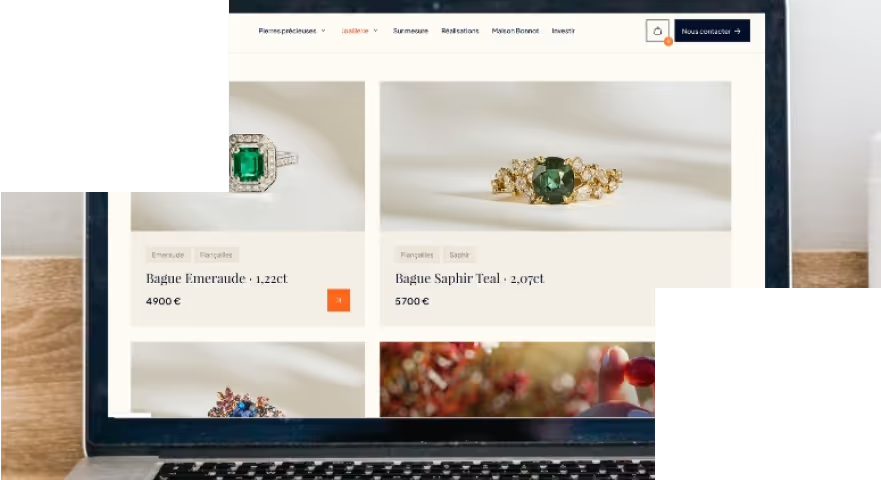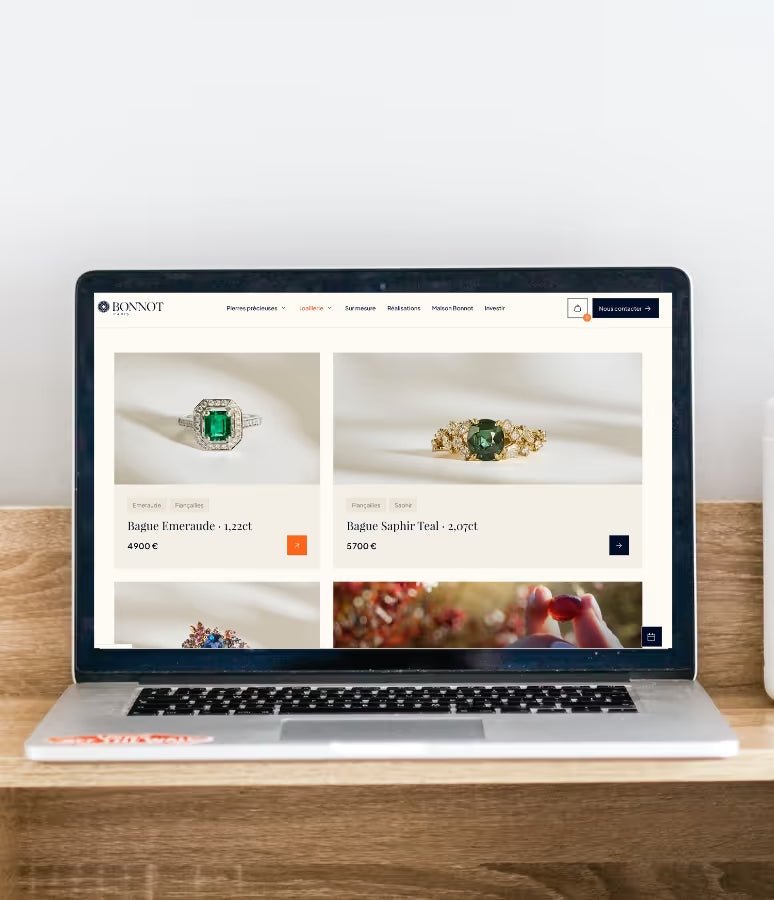Gemstone Guide

The precious stones captivate with their brilliance, history, and rarity. This guide helps you understand, appreciate, and confidently choose a stone with complete peace of mind. You will find simple explanations here, useful for online purchases. For any advice or questions, contact us: we are at your service.

1. The main families of stones: precious, semi-precious, and ornamental
Strictly speaking, precious stones are rare. There are only 4, and they are expensive. Semi-precious stones are more numerous and varied, but some can also be quite valuable. Ornamental stones offer a variety of textures and colors. Their wide availability means low prices.
1.1 Traditional gemstones
There are 4 gemstones:
The diamond is distinguished by its fire and hardness. It is transparent or colored (bicolor diamond, pink, etc.). The ruby is deep red and sapphires come in many shades. The emerald captivates with its deep and mysterious green. Their prestige is based on rarity, demand, and their durability.
1.2 Fine stones (often called "semi-precious")
All valuable stones that are not gemstones are called fine stones.Among the most popular:
- Amethyst
- Citrine
- Topaz
- Garnet
- Aquamarine
- Tourmaline
- Peridot
- Morganite
- Spinel
- Tanzanite
- Blue zircon
- Etc.
They cover all shades, from pastel to intense. Some are highly sought after, such as Paraiba tourmaline, vivid red spinels, or tanzanites. They offer an excellent beauty/price ratio.
Terminology note: the term "semi-precious" is commonly used. In commerce and gemology, however, the legal term is "fine stone".

SEE OUR BLUE SAPPHIRES
1.3 Ornamental stones
These are pretty stones, but they are not distinguished by their rarity or brilliance. Among them: lapis lazuli, jade, malachite, turquoise, tiger's eye, onyx, jasper, etc. They play on the material : veins, clouds, bands, glitter. The cabochon cut suits them, as do fancy cuts.
2. Why take an interest in stones?
For their aesthetic value: color, brilliance, transparency, unique textures. The harmonies vary with the light and the setting. A beautiful cut reveals the entire soul of a gem.
Precious stones often have an emotional value associated with beautiful jewelry: wedding anniversaries, birthstones, cultural meanings. A piece of jewelry tells a story and is worn like a talisman.
For heritage value. A precious stone is synonymous with rarity, durability, and potential for transmission. A beautiful stone can be kept and passed on… or resold with added value.
3.Where do precious and semi-precious stones come from?
The main deposits vary depending on the stones:
- Sapphires : Sri Lanka, Madagascar, historical Kashmir
- Rubies : Mozambique, Myanmar
- Emeralds : Colombia, Zambia
- Tanzanite : Tanzania
- Opals: Australia and Ethiopia
Each origin imparts a unique color and inclusion signature.
The typical process is as follows:
Mine → sorting → cutting → traders → jewelers
Some stones go through renowned cutting centers:
- Jaipur
- Bangkok
- Idar-Oberstein
- Antwerp for diamonds
At each stage, the quality is refined: cut, calibration, compliance.
Traceability is improving
Responsible sourcing initiatives such as that of Bonnot Paris, audits, independent labels and certificates improve the traceability of precious stones. Reputable houses document the origin when possible, and indicate treatments.Ethics concern the environment, working conditions, and the transparency of descriptions.
Bonnot Paris gemstones
The Bonnot Paris House selects stones based on strict criteria: beautiful color, perfect cut, harmonious proportions, certificate of authenticity and transparency regarding any treatments. Partners are chosen for their reliability, their commitment, and responsible sourcing channels.
Our positioning: consistent quality, precise size tolerances, treatments allowed only if they are stable and clearly indicated.
Added value for you: warranty, careful selection, and expert advice for every project, from the classic solitaire ring to a statement piece of jewelry.

4. Treatments and enhancements of gemstones: heated, treated, natural
Why treat a gemstone? To stabilize the color, improve clarity and reveal its aesthetic potential. These practices are accepted when they are disclosed, durable, and announced. The information must appear on the product sheet and, if possible, on the certificate.
Main treatments:
- Heating (very common for sapphires/rubies)
- Oiling (emeralds)
- Irradiation and annealing (blue topaz, sometimes quartz)
- Diffusion
- Fracture filling (filling)
The treatment of gemstones can remain compatible with jewelry use and ethics when disclosed. It influences value, perceived rarity, and care. A reputable seller indicates the treatment, its nature, and its stability upfront.
Tip: prioritize untreated or lightly treated stones for rarity. Or accept a standard treatment to optimize your budget, with full transparency.
5.How are gemstones produced?
Extraction methods include alluvial, open-pit mining and underground mining. Artisanal and small-scale activity is common for gems. It can boost local economies if properly regulated.
After extraction, the steps are:
- Washing
- Sorting
- Preforming
- Cutting
- Polishing
- Possible certification
Calibrated cuts are used for mass-produced jewelry. Exceptional pieces receive a custom workshop cut by an experienced lapidary, made to measure.
Environmental and social issues are significant. Water management, site rehabilitation, working conditions, safety.Best practices are based on local programs, partnerships, and responsible supply chains. At Bonnot Paris, we pay close attention to the ethical sourcing of our gemstones.

6. The art of cutting: revealing the brilliance of precious and semi-precious stones
The cut aims for brilliance, fire, symmetry, and proportions consistent with the refractive index of the cut stone. The cutter must try to obtain a finished product as heavy as possible, while enhancing its beauty. Sometimes, compromises must be made. A slight loss of weight can improve the light: this is a quality choice.
Common cuts and shapes: round brilliant, oval, pear, cushion, princess, emerald, marquise, heart. See our article on gemstone cutting for a complete guide on the subject.
Signs of a good cut: harmonious proportions, clear symmetry, no visible "window" or "extinction" on the face. Good polishing enhances brilliance. Sharp edges indicate careful craftsmanship.
7. How to determine the quality of a gemstone?
The "4Cs" apply to diamonds:
- Carat (weight)
- Color
- Clarity (Clarity)
- Cut (Cut)
SEE OUR DIAMONDS
Laboratory reports standardize grading. Fluorescence is an additional factor.
For colored gemstones, the priority is color: hue, saturation, tone. Next come clarity, cut, and weight.Commercial terms exist, but the proof remains visual. The vibrancy and uniformity of the color are paramount.
Some gemstones display optical phenomena: chatoyancy (cat’s eye), asterism (stars), adularescence (moonstone), pleochroism (multiple hues). These increase interest and influence the cutting.
Certificates and laboratories:
The certificate describes the variety, the probable origin, the treatments and the measurements. It is not a matter of taste, but a technical reference document.

8.Natural vs Synthetic Stones
Natural gemstones have been shaped by nature. They have typical inclusions and display organic variations.
Laboratory-grown or synthetic stones have the same chemical and crystalline composition as the natural version (e.g.: synthetic sapphire). They offer an ethical and more affordable alternative, with high purity. The downside is the absence of magic. After all, a fine stone is a miracle of nature.
Impacts on price, durability, and transparency: synthetic stones must be named accordingly, with laboratory mentioned.
9.Care of Gemstones and Durability
Hardness (from 1 to 10 on the Mohs scale) influences the care of a gemstone. Inclusions also matter when assessing the resistance of a stone. A hard gem can still be fragile to impacts if it has many inclusions.
Cleaning should be done with lukewarm water and mild soap, a soft brush, thorough rinsing, and a microfiber cloth. Avoid thermal shocks, harsh solvents, and ultrasound for fragile, oiled, or heavily included stones. Store them separately to prevent scratches.

10.How to buy online properly
Checklist before purchasing a gemstone :
- Ensure complete information : type of stone, weight (carats), dimensions, origin (if known), treatments, cut type
- Reliable visuals: macro photos and 360° video, various lighting conditions
- Buying a gemstone with a certificate is always recommended, especially for individuals without expertise
Budget tips
Unless you have an unlimited budget, you will probably need to make trade-offs. Color, cut, clarity, and weight should be prioritized according to your goals. A vivid color with a balanced cut often outweighs a higher weight. Set yourself a budget range and compare with equivalent characteristics.
If you need advice, we are always at your disposal to help you find the right gemstone and/or design your custom ring.
Founder of Bonnot Paris








